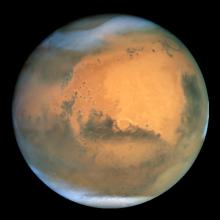An unmanned Atlas V rocket launched towards Mars from Cape Canaveral, Florida on Saturday, carrying the Mars Science Laboratory rover. The rover, dubbed Curiosity, will explore Mars's Gale Crater, looking for organic materials that might suggest life forms once existed on the planet.
It will take 8 1/2 months before Curiosity reaches the surface of Mars, more than 350 million miles away. It is scheduled to land on the planet's surface in August 2012.
The rover is 10 feet long and 9 feet wide, and weighs about 1 ton. It is powered by 10.6 pounds of radioactive plutonium, enabling it to work faster and travel farther than previous Mars rovers. Curiosity contains a mobile laboratory that can sample Martian soil and rocks and analyze them at the scene. A drill with a jackhammer is attached to the rover's 7 foot mechanical arm. The rover is also equipped with high-definition and laser cameras, as well as scientific instruments to help analyze the rocks and soil to determine if any life once existed on Mars.
The rover does not contain any life detectors. The purpose of the $2.5 million mission is to search for organic compound traces that would indicate previous life forms. The rover will also measure radiation levels on the surface of Mars to see if it will be possible to send astronauts to the planet in the future.
Curiosity will land in Gale Crater, an area rich in minerals. Scientist say that if life did exist on Mars at one time, Gale Crater is a prime area. Unlike its predecessors, Curiosity will use a jet pack and a tether system to land on Mars. This method should provide for a more accurate landing than the air bag system used by rovers Spirit and Opportunity. Curiosity will spend at least two years exploring Gale Crater.
